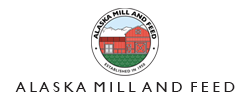Raw Food Basics | Alaska Mill & Feed
Posted by Kimberly McCourtney on Dec 4th 2020
Dogs and cats have eaten raw foods ever since it was first possible to call them dogs and cats. Raw foods can add variety to a diet, as well as viable beneficial bacteria and naturally occurring enzymes. Because most prepared raw diets for dogs and cats contain significant quantities of raw meat, it's important to handle them properly.
Raw food contains a higher
percentage of water than dry food.
New research indicates that food with higher moisture content may contribute to
the long-term health of the cat’s kidneys and urinary tract.
Raw food contains whole, natural
nutritional elements. The processing of dry kibble and canned food
can alter or eliminate certain food elements found in raw meats, bone,
vegetables and fruits. Raw food provides active enzymes, phytochemicals,
beneficial bacteria, food-based soluble fibers and antioxidants.
Raw food requires careful handling.
Hands, surfaces, containers and utensils should be sanitized after coming
in contact with raw foods, to prevent risks to people from improper handling of
raw meat. General good handling
practices for raw meats, as established by the
USDA, should be followed. Most people pull the amount of raw food to be fed the
next day from the freezer the day before and let it thaw overnight in the
refrigerator. If kept in a closed container, it should keep in the refrigerator
for 3-4 days.
Raw food may promote cleaner teeth.
Raw bones seem to greatly improve the cleanliness of the teeth and gums when
fed once a week.
Raw food has some risks, and may not
be right for every dog or cat. When raw food is processed and fed
properly, the incidence of illness is almost non-existent. What risks there are
fall into two categories: illness from bacteria or parasites in contaminated
meat, and intestinal infection and injuries from bones. These risks can be
serious, and weak or unhealthy dogs and cats may not be good candidates for raw
food.

